Medscape CME Activity
Medscape, LLC is pleased to provide online continuing medical education (CME) for selected journal articles, allowing clinicians the opportunity to earn CME credit. In support of improving patient care, these activities have been planned and implemented by Medscape, LLC and Emerging Infectious Diseases. Medscape, LLC is jointly accredited by the Accreditation Council for Continuing Medical Education (ACCME), the Accreditation Council for Pharmacy Education (ACPE), and the American Nurses Credentialing Center (ANCC), to provide continuing education for the healthcare team.
CME credit is available for one year after publication.
Volume 19—2013
Volume 19, Number 12—December 2013
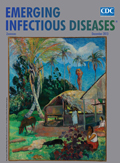
Powassan virus, a member of the tick-borne encephalitis group of flaviviruses, encompasses 2 lineages with separate enzootic cycles. The prototype lineage of Powassan virus (POWV) is principally maintained between Ixodes cookei ticks and the groundhog (Marmota momax) or striped skunk (Mephitis mephitis), whereas the deer tick virus (DTV) lineage is believed to be maintained between Ixodes scapularis ticks and the white-footed mouse (Peromyscus leucopus). We report 14 cases of Powassan encephalitis from New York during 2004–2012. Ten (72%) of the patients were residents of the Lower Hudson Valley, a Lyme disease–endemic area in which I. scapularis ticks account for most human tick bites. This finding suggests that many of these cases were caused by DTV rather than POWV. In 2 patients, DTV infection was confirmed by genetic sequencing. As molecular testing becomes increasingly available, more cases of Powassan encephalitis may be determined to be attributable to the DTV lineage.
| EID | El Khoury MY, Camargo JF, White JL, Backenson BP, Dupuis AP, Escuyer KL, et al. Potential Role of Deer Tick Virus in Powassan Encephalitis Cases in Lyme Disease–endemic Areas of New York, USA. Emerg Infect Dis. 2013;19(12):1926-1933. https://doi.org/10.3201/eid1912.130903 |
|---|---|
| AMA | El Khoury MY, Camargo JF, White JL, et al. Potential Role of Deer Tick Virus in Powassan Encephalitis Cases in Lyme Disease–endemic Areas of New York, USA. Emerging Infectious Diseases. 2013;19(12):1926-1933. doi:10.3201/eid1912.130903. |
| APA | El Khoury, M. Y., Camargo, J. F., White, J. L., Backenson, B. P., Dupuis, A. P., Escuyer, K. L....Wong, S. J. (2013). Potential Role of Deer Tick Virus in Powassan Encephalitis Cases in Lyme Disease–endemic Areas of New York, USA. Emerging Infectious Diseases, 19(12), 1926-1933. https://doi.org/10.3201/eid1912.130903. |
Rift Valley fever (RVF) is an emerging zoonosis posing a public health threat to humans in Africa. During sporadic RVF outbreaks in 2008–2009 and widespread epidemics in 2010–2011, 302 laboratory-confirmed human infections, including 25 deaths (case-fatality rate, 8%) were identified. Incidence peaked in late summer to early autumn each year, which coincided with incidence rate patterns in livestock. Most case-patients were adults (median age 43 years), men (262; 87%), who worked in farming, animal health or meat-related industries (83%). Most case-patients reported direct contact with animal tissues, blood, or other body fluids before onset of illness (89%); mosquitoes likely played a limited role in transmission of disease to humans. Close partnership with animal health and agriculture sectors allowed early recognition of human cases and appropriate preventive health messaging.
| EID | Archer BN, Thomas J, Weyer J, Cengimbo A, Landoh DE, Jacobs C, et al. Epidemiologic Investigations into Outbreaks of Rift Valley Fever in Humans, South Africa, 2008–2011. Emerg Infect Dis. 2013;19(12):1918-1925. https://doi.org/10.3201/eid1912.121527 |
|---|---|
| AMA | Archer BN, Thomas J, Weyer J, et al. Epidemiologic Investigations into Outbreaks of Rift Valley Fever in Humans, South Africa, 2008–2011. Emerging Infectious Diseases. 2013;19(12):1918-1925. doi:10.3201/eid1912.121527. |
| APA | Archer, B. N., Thomas, J., Weyer, J., Cengimbo, A., Landoh, D. E., Jacobs, C....Blumberg, L. (2013). Epidemiologic Investigations into Outbreaks of Rift Valley Fever in Humans, South Africa, 2008–2011. Emerging Infectious Diseases, 19(12), 1918-1925. https://doi.org/10.3201/eid1912.121527. |
Volume 19, Number 11—November 2013

Tropheryma whipplei endocarditis differs from classic Whipple disease, which primarily affects the gastrointestinal system. We diagnosed 28 cases of T. whipplei endocarditis in Marseille, France, and compared them with cases reported in the literature. Specimens were analyzed mostly by molecular and histologic techniques. Duke criteria were ineffective for diagnosis before heart valve analysis. The disease occurred in men 40–80 years of age, of whom 21 (75%) had arthralgia (75%); 9 (32%) had valvular disease and 11 (39%) had fever. Clinical manifestations were predominantly cardiologic. Treatment with doxycycline and hydroxychloroquine for at least 12 months was successful. The cases we diagnosed differed from those reported from Germany, in which arthralgias were less common and previous valve lesions more common. A strong geographic specificity for this disease is found mainly in eastern-central France, Switzerland, and Germany. T. whipplei endocarditis is an emerging clinical entity observed in middle-aged and older men with arthralgia.
| EID | Fenollar F, Célard M, Lagier J, Lepidi H, Fournier P, Raoult D. Tropheryma whipplei Endocarditis. Emerg Infect Dis. 2013;19(11):1721-1730. https://doi.org/10.3201/eid1911.121356 |
|---|---|
| AMA | Fenollar F, Célard M, Lagier J, et al. Tropheryma whipplei Endocarditis. Emerging Infectious Diseases. 2013;19(11):1721-1730. doi:10.3201/eid1911.121356. |
| APA | Fenollar, F., Célard, M., Lagier, J., Lepidi, H., Fournier, P., & Raoult, D. (2013). Tropheryma whipplei Endocarditis. Emerging Infectious Diseases, 19(11), 1721-1730. https://doi.org/10.3201/eid1911.121356. |
Inflammatory bowel disease (IBD) is a risk factor for Clostridium difficile infections (CDIs). Because of similar disruptions to the intestinal microbiome found in IBD and in obesity, we conducted a retrospective study to clarify the role of obesity in CDI. We reviewed records of patients with laboratory-confirmed CDIs in a tertiary care medical center over a 6-month period. Of 132 patients, 43% had community onset, 30% had health care facility onset, and 23% had community onset infections after exposure to a health care facility. Patients with community onset infections had higher body mass indices than the general population and those with community onset after exposure to a health care facility, had higher rates of IBD, and lower prior antibacterial drug exposure than patients who had CDI onset in a health care facility. Obesity may be associated with CDI, independent of antibacterial drug or health care exposures.
| EID | Leung J, Burke B, Ford D, Garvin G, Korn C, Sulis C, et al. Possible Association between Obesity and Clostridium difficile Infection. Emerg Infect Dis. 2013;19(11):1791-1798. https://doi.org/10.3201/eid1911.130618 |
|---|---|
| AMA | Leung J, Burke B, Ford D, et al. Possible Association between Obesity and Clostridium difficile Infection. Emerging Infectious Diseases. 2013;19(11):1791-1798. doi:10.3201/eid1911.130618. |
| APA | Leung, J., Burke, B., Ford, D., Garvin, G., Korn, C., Sulis, C....Bhadelia, N. (2013). Possible Association between Obesity and Clostridium difficile Infection. Emerging Infectious Diseases, 19(11), 1791-1798. https://doi.org/10.3201/eid1911.130618. |
Volume 19, Number 10—October 2013
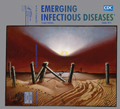
Invasive fusariosis (IF) is an infection with Fusarium spp. fungi that primarily affects patients with hematologic malignancies and hematopoietic cell transplant recipients. A cutaneous portal of entry is occasionally reported. We reviewed all cases of IF in Brazil during 2000–2010, divided into 2 periods: 2000–2005 (period 1) and 2006–2010 (period 2). We calculated incidence rates of IF and of superficial infections with Fusarium spp. fungi identified in patients at a dermatology outpatient unit. IF incidence for periods 1 and 2 was 0.86 cases versus 10.23 cases per 1,000 admissions (p<0.001), respectively; superficial fusarial infection incidence was 7.23 versus 16.26 positive cultures per 1,000 superficial cultures (p<0.001), respectively. Of 21 cases of IF, 14 showed a primary cutaneous portal of entry. Further studies are needed to identify reservoirs of these fungi in the community and to implement preventive measures for patients at risk.
| EID | Nucci M, Varon AG, Garnica M, Akiti T, Barreiros G, Trope B, et al. Increased Incidence of Invasive Fusariosis with Cutaneous Portal of Entry, Brazil. Emerg Infect Dis. 2013;19(10):1567-1572. https://doi.org/10.3201/eid1910.120847 |
|---|---|
| AMA | Nucci M, Varon AG, Garnica M, et al. Increased Incidence of Invasive Fusariosis with Cutaneous Portal of Entry, Brazil. Emerging Infectious Diseases. 2013;19(10):1567-1572. doi:10.3201/eid1910.120847. |
| APA | Nucci, M., Varon, A. G., Garnica, M., Akiti, T., Barreiros, G., Trope, B....Nouér, S. A. (2013). Increased Incidence of Invasive Fusariosis with Cutaneous Portal of Entry, Brazil. Emerging Infectious Diseases, 19(10), 1567-1572. https://doi.org/10.3201/eid1910.120847. |
Clonal VGII subtypes (outbreak strains) of Cryptococcus gattii have caused an outbreak in the US Pacific Northwest since 2004. Outbreak-associated infections occur equally in male and female patients (median age 56 years) and usually cause pulmonary disease in persons with underlying medical conditions. Since 2009, a total of 25 C. gattii infections, 23 (92%) caused by non–outbreak strain C. gattii, have been reported from 8 non–Pacific Northwest states. Sixteen (64%) patients were previously healthy, and 21 (84%) were male; median age was 43 years (range 15–83 years). Ten patients who provided information reported no past-year travel to areas where C. gattii is known to be endemic. Nineteen (76%) patients had central nervous system infections; 6 (24%) died. C. gattii infection in persons without exposure to known disease-endemic areas suggests possible endemicity in the United States outside the outbreak-affected region; these infections appear to differ in clinical and demographic characteristics from outbreak-associated C. gattii. Clinicians outside the outbreak-affected areas should be aware of locally acquired C. gattii infection and its varied signs and symptoms.
| EID | Harris JR, Lockhart SR, Sondermeyer G, Vugia DJ, Crist MB, D’Angelo M, et al. Cryptococcus gattii Infections in Multiple States Outside the US Pacific Northwest. Emerg Infect Dis. 2013;19(10):1621-1627. https://doi.org/10.3201/eid1910.130441 |
|---|---|
| AMA | Harris JR, Lockhart SR, Sondermeyer G, et al. Cryptococcus gattii Infections in Multiple States Outside the US Pacific Northwest. Emerging Infectious Diseases. 2013;19(10):1621-1627. doi:10.3201/eid1910.130441. |
| APA | Harris, J. R., Lockhart, S. R., Sondermeyer, G., Vugia, D. J., Crist, M. B., D’Angelo, M....Park, B. J. (2013). Cryptococcus gattii Infections in Multiple States Outside the US Pacific Northwest. Emerging Infectious Diseases, 19(10), 1621-1627. https://doi.org/10.3201/eid1910.130441. |
Volume 19, Number 9—September 2013
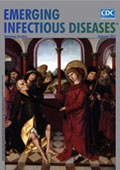
Although the measles-mumps-rubella (MMR) vaccine is not recommended for mumps postexposure prophylaxis (PEP), data on its effectiveness are limited. During the 2009–2010 mumps outbreak in the northeastern United States, we assessed effectiveness of PEP with a third dose of MMR vaccine among contacts in Orthodox Jewish households who were given a third dose within 5 days of mumps onset in the household’s index patient. We compared mumps attack rates between persons who received a third MMR dose during the first incubation period after onset in the index patient and 2-dose vaccinated persons who had not. Twenty-eight (11.7%) of 239 eligible household members received a third MMR dose as PEP. Mumps attack rates were 0% among third-dose recipients versus 5.2% among 2-dose recipients without PEP (p = 0.57). Although a third MMR dose administered as PEP did not have a significant effect, it may offer some benefits in specific outbreak contexts.
| EID | Fiebelkorn A, Lawler J, Curns AT, Brandeburg C, Wallace GS. Mumps Postexposure Prophylaxis with a Third Dose of Measles-Mumps-Rubella Vaccine, Orange County, New York, USA. Emerg Infect Dis. 2013;19(9):1411-1417. https://doi.org/10.3201/eid1909.130299 |
|---|---|
| AMA | Fiebelkorn A, Lawler J, Curns AT, et al. Mumps Postexposure Prophylaxis with a Third Dose of Measles-Mumps-Rubella Vaccine, Orange County, New York, USA. Emerging Infectious Diseases. 2013;19(9):1411-1417. doi:10.3201/eid1909.130299. |
| APA | Fiebelkorn, A., Lawler, J., Curns, A. T., Brandeburg, C., & Wallace, G. S. (2013). Mumps Postexposure Prophylaxis with a Third Dose of Measles-Mumps-Rubella Vaccine, Orange County, New York, USA. Emerging Infectious Diseases, 19(9), 1411-1417. https://doi.org/10.3201/eid1909.130299. |
Volume 19, Number 8—August 2013
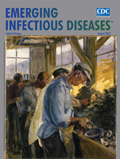
A prospective cohort study was performed among travelers from the Netherlands to investigate the acquisition of carbapenemase-producing Enterobacteriaceae (CP-E) and extended-spectrum β-lactamase–producing Enterobacteriaceae (ESBL-E) and associated risk factors. Questionnaires were administered and rectal swabs were collected and tested before and after return. Of 370 travelers, 32 (8.6%) were colonized with ESBL-E before travel; 113 (30.5%) acquired an ESBL-E during travel, and 26 were still colonized 6 months after return. No CP-E were found. Independent risk factors for ESBL-E acquisition were travel to South and East Asia. Multilocus sequence typing showed extensive genetic diversity among Escherichia coli. Predominant ESBLs were CTX-M enzymes. The acquisition rate, 30.5%, of ESBL-E in travelers from the Netherlands to all destinations studied was high. Active surveillance for ESBL-E and CP-E and contact isolation precautions may be recommended at admission to medical facilities for patients who traveled to Asia during the previous 6 months.
| EID | Paltansing S, Vlot JA, Kraakman M, Mesman R, Bruijning ML, Bernards AT, et al. Extended-Spectrum β-Lactamase–producing Enterobacteriaceae among Travelers from the Netherlands. Emerg Infect Dis. 2013;19(8):1206-1213. https://doi.org/10.3201/eid1908.130257 |
|---|---|
| AMA | Paltansing S, Vlot JA, Kraakman M, et al. Extended-Spectrum β-Lactamase–producing Enterobacteriaceae among Travelers from the Netherlands. Emerging Infectious Diseases. 2013;19(8):1206-1213. doi:10.3201/eid1908.130257. |
| APA | Paltansing, S., Vlot, J. A., Kraakman, M., Mesman, R., Bruijning, M. L., Bernards, A. T....Veldkamp, K. (2013). Extended-Spectrum β-Lactamase–producing Enterobacteriaceae among Travelers from the Netherlands. Emerging Infectious Diseases, 19(8), 1206-1213. https://doi.org/10.3201/eid1908.130257. |
During 2012, global detection of a new norovirus (NoV) strain, GII.4 Sydney, raised concerns about its potential effect in the United States. We analyzed data from NoV outbreaks in 5 states and emergency department visits for gastrointestinal illness in 1 state during the 2012–13 season and compared the data with those of previous seasons. During August 2012–April 2013, a total of 637 NoV outbreaks were reported compared with 536 and 432 in 2011–2012 and 2010–2011 during the same period. The proportion of outbreaks attributed to GII.4 Sydney increased from 8% in September 2012 to 82% in March 2013. The increase in emergency department visits for gastrointestinal illness during the 2012–13 season was similar to that of previous seasons. GII.4 Sydney has become the predominant US NoV outbreak strain during the 2012–13 season, but its emergence did not cause outbreak activity to substantially increase from that of previous seasons.
| EID | Leshem E, Wikswo M, Barclay L, Brandt E, Storm W, Salehi E, et al. Effects and Clinical Significance of GII.4 Sydney Norovirus, United States, 2012–2013. Emerg Infect Dis. 2013;19(8):1231-1238. https://doi.org/10.3201/eid1908.130458 |
|---|---|
| AMA | Leshem E, Wikswo M, Barclay L, et al. Effects and Clinical Significance of GII.4 Sydney Norovirus, United States, 2012–2013. Emerging Infectious Diseases. 2013;19(8):1231-1238. doi:10.3201/eid1908.130458. |
| APA | Leshem, E., Wikswo, M., Barclay, L., Brandt, E., Storm, W., Salehi, E....Hall, A. J. (2013). Effects and Clinical Significance of GII.4 Sydney Norovirus, United States, 2012–2013. Emerging Infectious Diseases, 19(8), 1231-1238. https://doi.org/10.3201/eid1908.130458. |
Volume 19, Number 7—July 2013
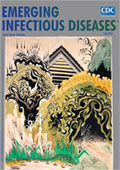
Streptococcus equi subspecies zooepidemicus (S. zooepidemicus) is a zoonotic pathogen for persons in contact with horses. In horses, S. zooepidemicus is an opportunistic pathogen, but human infections associated with S. zooepidemicus are often severe. Within 6 months in 2011, 3 unrelated cases of severe, disseminated S. zooepidemicus infection occurred in men working with horses in eastern Finland. To clarify the pathogen’s epidemiology, we describe the clinical features of the infection in 3 patients and compare the S. zooepidemicus isolates from the human cases with S. zooepidemicus isolates from horses. The isolates were analyzed by using pulsed-field gel electrophoresis, multilocus sequence typing, and sequencing of the szP gene. Molecular typing methods showed that human and equine isolates were identical or closely related. These results emphasize that S. zooepidemicus transmitted from horses can lead to severe infections in humans. As leisure and professional equine sports continue to grow, this infection should be recognized as an emerging zoonosis.
| EID | Pelkonen S, Lindahl SB, Suomala P, Karhukorpi J, Vuorinen S, Koivula I, et al. Transmission of Streptococcus equi Subspecies zooepidemicus Infection from Horses to Humans. Emerg Infect Dis. 2013;19(7):1041-1048. https://doi.org/10.3201/eid1907.121365 |
|---|---|
| AMA | Pelkonen S, Lindahl SB, Suomala P, et al. Transmission of Streptococcus equi Subspecies zooepidemicus Infection from Horses to Humans. Emerging Infectious Diseases. 2013;19(7):1041-1048. doi:10.3201/eid1907.121365. |
| APA | Pelkonen, S., Lindahl, S. B., Suomala, P., Karhukorpi, J., Vuorinen, S., Koivula, I....Tuuminen, T. (2013). Transmission of Streptococcus equi Subspecies zooepidemicus Infection from Horses to Humans. Emerging Infectious Diseases, 19(7), 1041-1048. https://doi.org/10.3201/eid1907.121365. |
Volume 19, Number 6—June 2013
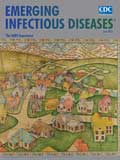
Pediatric infectious disease clinicians in industrialized countries may encounter iatrogenically transmitted HIV, hepatitis B virus, and hepatitis C virus infections in refugee children from Central Asia, Southeast Asia, and sub-Saharan Africa. The consequences of political collapse and/or civil war—work migration, prostitution, intravenous drug use, defective public health resources, and poor access to good medical care—all contribute to the spread of blood-borne viruses. Inadequate infection control practices by medical establishments can lead to iatrogenic infection of children. Summaries of 4 cases in refugee children in Australia are a salient reminder of this problem.
| EID | Goldwater PN. Iatrogenic Blood-borne Viral Infections in Refugee Children from War and Transition Zones. Emerg Infect Dis. 2013;19(6):892-898. https://doi.org/10.3201/eid1906.120806 |
|---|---|
| AMA | Goldwater PN. Iatrogenic Blood-borne Viral Infections in Refugee Children from War and Transition Zones. Emerging Infectious Diseases. 2013;19(6):892-898. doi:10.3201/eid1906.120806. |
| APA | Goldwater, P. N. (2013). Iatrogenic Blood-borne Viral Infections in Refugee Children from War and Transition Zones. Emerging Infectious Diseases, 19(6), 892-898. https://doi.org/10.3201/eid1906.120806. |
| EID | Leclair D, Fung J, Isaac-Renton JL, Proulx J, May-Hadford J, Ellis A, et al. Foodborne Botulism in Canada, 1985–2005. Emerg Infect Dis. 2013;19(6):961-968. https://doi.org/10.3201/eid1906.120873 |
|---|---|
| AMA | Leclair D, Fung J, Isaac-Renton JL, et al. Foodborne Botulism in Canada, 1985–2005. Emerging Infectious Diseases. 2013;19(6):961-968. doi:10.3201/eid1906.120873. |
| APA | Leclair, D., Fung, J., Isaac-Renton, J. L., Proulx, J., May-Hadford, J., Ellis, A....Austin, J. W. (2013). Foodborne Botulism in Canada, 1985–2005. Emerging Infectious Diseases, 19(6), 961-968. https://doi.org/10.3201/eid1906.120873. |
Volume 19, Number 5—May 2013
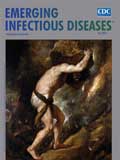
Beijing strains are speculated to have a selective advantage over other Mycobacterium tuberculosis strains because of increased transmissibility and virulence. In Alberta, a province of Canada that receives a large number of immigrants, we conducted a population-based study to determine whether Beijing strains were associated with increased transmission leading to disease compared with non-Beijing strains. Beijing strains accounted for 258 (19%) of 1,379 pulmonary tuberculosis cases in 1991–2007; overall, 21% of Beijing cases and 37% of non-Beijing cases were associated with transmission clusters. Beijing index cases had significantly fewer secondary cases within 2 years than did non-Beijing cases, but this difference disappeared after adjustment for demographic characteristics, infectiousness, and M. tuberculosis lineage. In a province that has effective tuberculosis control, transmission of Beijing strains posed no more of a public health threat than did non-Beijing strains.
| EID | Langlois-Klassen D, Senthilselvan A, Chui L, Kunimoto D, Saunders L, Menzies D, et al. Transmission of Mycobacterium tuberculosis Beijing Strains, Alberta, Canada, 1991–2007. Emerg Infect Dis. 2013;19(5):701-711. https://doi.org/10.3201/eid1905.121578 |
|---|---|
| AMA | Langlois-Klassen D, Senthilselvan A, Chui L, et al. Transmission of Mycobacterium tuberculosis Beijing Strains, Alberta, Canada, 1991–2007. Emerging Infectious Diseases. 2013;19(5):701-711. doi:10.3201/eid1905.121578. |
| APA | Langlois-Klassen, D., Senthilselvan, A., Chui, L., Kunimoto, D., Saunders, L., Menzies, D....Long, R. (2013). Transmission of Mycobacterium tuberculosis Beijing Strains, Alberta, Canada, 1991–2007. Emerging Infectious Diseases, 19(5), 701-711. https://doi.org/10.3201/eid1905.121578. |
Volume 19, Number 4—April 2013
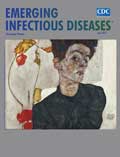
Group B Streptococcus (GBS) is a major cause of invasive disease in neonates in the United States. Surveillance of invasive GBS disease in Minnesota, USA, during 2000–2010 yielded 449 isolates from 449 infants; 257 had early-onset (EO) disease (by age 6 days) and 192 late-onset (LO) disease (180 at age 7–89 days, 12 at age 90–180 days). Isolates were characterized by capsular polysaccharide serotype and surface-protein profile; types III and Ia predominated. However, because previously uncommon serotype IV constitutes 5/31 EO isolates in 2010, twelve type IV isolates collected during 2000–2010 were studied further. By pulsed-field gel electrophoresis, they were classified into 3 profiles; by multilocus sequence typing, representative isolates included new sequence type 468. Resistance to clindamycin or erythromycin was detected in 4/5 serotype IV isolates. Emergence of serotype IV GBS in Minnesota highlights the need for serotype prevalence monitoring to detect trends that could affect prevention strategies.
| EID | Ferrieri P, Lynfield R, Creti R, Flores AE. Serotype IV and Invasive Group B Streptococcus Disease in Neonates, Minnesota, USA, 2000–2010. Emerg Infect Dis. 2013;19(4):551-558. https://doi.org/10.3201/eid1904.121572 |
|---|---|
| AMA | Ferrieri P, Lynfield R, Creti R, et al. Serotype IV and Invasive Group B Streptococcus Disease in Neonates, Minnesota, USA, 2000–2010. Emerging Infectious Diseases. 2013;19(4):551-558. doi:10.3201/eid1904.121572. |
| APA | Ferrieri, P., Lynfield, R., Creti, R., & Flores, A. E. (2013). Serotype IV and Invasive Group B Streptococcus Disease in Neonates, Minnesota, USA, 2000–2010. Emerging Infectious Diseases, 19(4), 551-558. https://doi.org/10.3201/eid1904.121572. |
This prospective cohort study, performed during the 2009 influenza A(H1N1) pandemic, was aimed to determine whether adults working in acute care hospitals were at higher risk than other working adults for influenza and to assess risk factors for influenza among health care workers (HCWs). We assessed the risk for influenza among 563 HCWs and 169 non-HCWs using PCR to test nasal swab samples collected during acute respiratory illness; results for 13 (2.2%) HCWs and 7 (4.1%) non-HCWs were positive for influenza. Influenza infection was associated with contact with family members who had acute respiratory illnesses (adjusted odds ratio [AOR]: 6.9, 95% CI 2.2–21.8); performing aerosol-generating medical procedures (AOR 2.0, 95% CI 1.1–3.5); and low self-reported adherence to hand hygiene recommendations (AOR 0.9, 95% CI 0.7–1.0). Contact with persons with acute respiratory illness, rather than workplace, was associated with influenza infection. Adherence to infection control recommendations may prevent influenza among HCWs.
| EID | Kuster SP, Coleman BL, Raboud J, McNeil S, De Serres G, Gubbay J, et al. Risk Factors for Influenza among Health Care Workers during 2009 Pandemic, Toronto, Ontario, Canada. Emerg Infect Dis. 2013;19(4):606-615. https://doi.org/10.3201/eid1904.111812 |
|---|---|
| AMA | Kuster SP, Coleman BL, Raboud J, et al. Risk Factors for Influenza among Health Care Workers during 2009 Pandemic, Toronto, Ontario, Canada. Emerging Infectious Diseases. 2013;19(4):606-615. doi:10.3201/eid1904.111812. |
| APA | Kuster, S. P., Coleman, B. L., Raboud, J., McNeil, S., De Serres, G., Gubbay, J....McGeer, A. J. (2013). Risk Factors for Influenza among Health Care Workers during 2009 Pandemic, Toronto, Ontario, Canada. Emerging Infectious Diseases, 19(4), 606-615. https://doi.org/10.3201/eid1904.111812. |
Volume 19, Number 3—March 2013
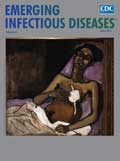
After an increase in the number of reported cases of Pneumocystis jirovecii pneumonia in England, we investigated data from 2000–2010 to verify the increase. We analyzed national databases for microbiological and clinical diagnoses of P. jirovecii pneumonia and associated deaths. We found that laboratory-confirmed cases in England had increased an average of 7% per year and that death certifications and hospital admissions also increased. Hospital admissions indicated increased P. jirovecii pneumonia diagnoses among patients not infected with HIV, particularly among those who had received a transplant or had a hematologic malignancy. A new risk was identified: preexisting lung disease. Infection rates among HIV-positive adults decreased. The results confirm that diagnoses of potentially preventable P. jirovecii pneumonia among persons outside the known risk group of persons with HIV infection have increased. This finding warrants further characterization of risk groups and a review of P. jirovecii pneumonia prevention strategies.
| EID | Maini R, Henderson KL, Sheridan EA, Lamagni T, Nichols G, Delpech V, et al. Increasing Pneumocystis Pneumonia, England, UK, 2000–2010. Emerg Infect Dis. 2013;19(3):386-392. https://doi.org/10.3201/eid1903.121151 |
|---|---|
| AMA | Maini R, Henderson KL, Sheridan EA, et al. Increasing Pneumocystis Pneumonia, England, UK, 2000–2010. Emerging Infectious Diseases. 2013;19(3):386-392. doi:10.3201/eid1903.121151. |
| APA | Maini, R., Henderson, K. L., Sheridan, E. A., Lamagni, T., Nichols, G., Delpech, V....Phin, N. (2013). Increasing Pneumocystis Pneumonia, England, UK, 2000–2010. Emerging Infectious Diseases, 19(3), 386-392. https://doi.org/10.3201/eid1903.121151. |
To identify clinical and therapeutic features of pulmonary nontuberculous mycobacterial (PNTM) disease, we conducted a retrospective analysis of patients referred to the Brazilian reference center, Oswaldo Cruz Foundation, Rio de Janeiro, Brazil, who received a diagnosis of PNTM during 1993–2011 with at least 1 respiratory culture positive for NTM. Associated conditions included bronchiectasis (21.8%), chronic obstructive pulmonary disease (20.7%), cardiovascular disease (15.5%), AIDS (9.8%), diabetes (9.8%), and hepatitis C (4.6%).Two patients had Hansen disease; 1 had Marfan syndrome. Four mycobacterial species comprised 85.6% of NTM infections: Mycobacterium kansasii, 59 cases (33.9%); M. avium complex, 53 (30.4%); M. abscessus, 23 (13.2%); and M. fortuitum, 14 (8.0%). A total of 42 (24.1%) cases were associated with rapidly growing mycobacteria. In countries with a high prevalence of tuberculosis, PNTM is likely misdiagnosed as tuberculosis, thus showing the need for improved capacity to diagnose mycobacterial disease as well as greater awareness of PNTM disease prevalence.
| EID | Couto de Mello K, Mello F, Borga L, Rolla V, Duarte RS, Sampaio EP, et al. Clinical and Therapeutic Features of Pulmonary Nontuberculous Mycobacterial Disease, Rio de Janeiro, Brazil. Emerg Infect Dis. 2013;19(3):393-399. https://doi.org/10.3201/eid1903.120735 |
|---|---|
| AMA | Couto de Mello K, Mello F, Borga L, et al. Clinical and Therapeutic Features of Pulmonary Nontuberculous Mycobacterial Disease, Rio de Janeiro, Brazil. Emerging Infectious Diseases. 2013;19(3):393-399. doi:10.3201/eid1903.120735. |
| APA | Couto de Mello, K., Mello, F., Borga, L., Rolla, V., Duarte, R. S., Sampaio, E. P....Dalcolmo, M. P. (2013). Clinical and Therapeutic Features of Pulmonary Nontuberculous Mycobacterial Disease, Rio de Janeiro, Brazil. Emerging Infectious Diseases, 19(3), 393-399. https://doi.org/10.3201/eid1903.120735. |
To understand the epidemiology of tuberculosis (TB) and HIV co-infection in California, we cross-matched incident TB cases reported to state surveillance systems during 1993–2008 with cases in the state HIV/AIDS registry. Of 57,527 TB case-patients, 3,904 (7%) had known HIV infection. TB rates for persons with HIV declined from 437 to 126 cases/100,000 persons during 1993–2008; rates were highest for Hispanics (225/100,000) and Blacks (148/100,000). Patients co-infected with TB–HIV during 2001–2008 were significantly more likely than those infected before highly active antiretroviral therapy became available to be foreign born, Hispanic, or Asian/Pacific Islander and to have pyrazinamide-monoresistant TB. Death rates decreased after highly active antiretroviral therapy became available but remained twice that for TB patients without HIV infection and higher for women. In California, HIV-associated TB has concentrated among persons from low and middle income countries who often acquire HIV infection in the peri-immigration period.
| EID | Metcalfe JZ, Porco TC, Westenhouse J, Damesyn M, Facer M, Hill J, et al. Tuberculosis and HIV Co-infection, California, USA, 1993–2008. Emerg Infect Dis. 2013;19(3):400-406. https://doi.org/10.3201/eid1903.121521 |
|---|---|
| AMA | Metcalfe JZ, Porco TC, Westenhouse J, et al. Tuberculosis and HIV Co-infection, California, USA, 1993–2008. Emerging Infectious Diseases. 2013;19(3):400-406. doi:10.3201/eid1903.121521. |
| APA | Metcalfe, J. Z., Porco, T. C., Westenhouse, J., Damesyn, M., Facer, M., Hill, J....Flood, J. (2013). Tuberculosis and HIV Co-infection, California, USA, 1993–2008. Emerging Infectious Diseases, 19(3), 400-406. https://doi.org/10.3201/eid1903.121521. |
Volume 19, Number 2—February 2013
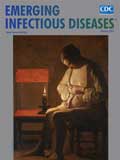
To investigate characteristics of hepatitis E cases in the United States, we tested samples from persons seronegative for acute hepatitis A and B whose clinical specimens were referred to the Centers for Disease Control and Prevention during June 2005–March 2012 for hepatitis E virus (HEV) testing. We found that 26 (17%) of 154 persons tested had hepatitis E. Of these, 15 had not recently traveled abroad (nontravelers), and 11 had (travelers). Compared with travelers, nontravelers were older (median 61 vs. 32 years of age) and more likely to be anicteric (53% vs. 8%); the nontraveler group also had fewer persons of South Asian ethnicity (7% vs. 73%) and more solid-organ transplant recipients (47% vs. 0). HEV genotype 3 was characterized from 8 nontravelers and genotypes 1 or 4 from 4 travelers. Clinicians should consider HEV infection in the differential diagnosis of hepatitis, regardless of patient travel history.
| EID | Drobeniuc J, Greene-Montfort T, Le N, Mixson-Hayden TR, Ganova-Raeva L, Dong C, et al. Laboratory-based Surveillance for Hepatitis E Virus Infection, United States, 2005–2012. Emerg Infect Dis. 2013;19(2):218-222. https://doi.org/10.3201/eid1902.120961 |
|---|---|
| AMA | Drobeniuc J, Greene-Montfort T, Le N, et al. Laboratory-based Surveillance for Hepatitis E Virus Infection, United States, 2005–2012. Emerging Infectious Diseases. 2013;19(2):218-222. doi:10.3201/eid1902.120961. |
| APA | Drobeniuc, J., Greene-Montfort, T., Le, N., Mixson-Hayden, T. R., Ganova-Raeva, L., Dong, C....Teo, C. (2013). Laboratory-based Surveillance for Hepatitis E Virus Infection, United States, 2005–2012. Emerging Infectious Diseases, 19(2), 218-222. https://doi.org/10.3201/eid1902.120961. |
We describe the clinical, laboratory, and radiographic characteristics of 15 cases of eastern equine encephalitis in children during 1970–2010. The most common clinical and laboratory features were fever, headache, seizures, peripheral leukocytosis, and cerebrospinal fluid neutrophilic pleocytosis. Radiographic lesions were found in the basal ganglia, thalami, and cerebral cortex. Clinical outcomes included severe neurologic deficits in 5 (33%) patients, death of 4 (27%), full recovery of 4 (27%), and mild neurologic deficits in 2 (13%). We identify an association between a short prodrome and an increased risk for death or for severe disease.
| EID | Silverman MA, Misasi J, Smole S, Feldman HA, Cohen AB, Santagata S, et al. Eastern Equine Encephalitis in Children, Massachusetts and New Hampshire,USA, 1970–2010. Emerg Infect Dis. 2013;19(2):194-201. https://doi.org/10.3201/eid1902.120039 |
|---|---|
| AMA | Silverman MA, Misasi J, Smole S, et al. Eastern Equine Encephalitis in Children, Massachusetts and New Hampshire,USA, 1970–2010. Emerging Infectious Diseases. 2013;19(2):194-201. doi:10.3201/eid1902.120039. |
| APA | Silverman, M. A., Misasi, J., Smole, S., Feldman, H. A., Cohen, A. B., Santagata, S....Ahmed, A. A. (2013). Eastern Equine Encephalitis in Children, Massachusetts and New Hampshire,USA, 1970–2010. Emerging Infectious Diseases, 19(2), 194-201. https://doi.org/10.3201/eid1902.120039. |
Volume 19, Number 1—January 2013
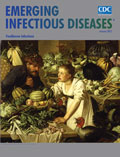
Listeria monocytogenes, a bacterial foodborne pathogen, can cause meningitis, bacteremia, and complications during pregnancy. This report summarizes listeriosis outbreaks reported to the Foodborne Disease Outbreak Surveillance System of the Centers for Disease Control and Prevention during 1998–2008. The study period includes the advent of PulseNet (a national molecular subtyping network for outbreak detection) in 1998 and the Listeria Initiative (enhanced surveillance for outbreak investigation) in 2004. Twenty-four confirmed listeriosis outbreaks were reported during 1998–2008, resulting in 359 illnesses, 215 hospitalizations, and 38 deaths. Outbreaks earlier in the study period were generally larger and longer. Serotype 4b caused the largest number of outbreaks and outbreak-associated cases. Ready-to-eat meats caused more early outbreaks, and novel vehicles (i.e., sprouts, taco/nacho salad) were associated with outbreaks later in the study period. These changes may reflect the effect of PulseNet and the Listeria Initiative and regulatory initiatives designed to prevent contamination in ready-to-eat meat and poultry products.
| EID | Cartwright EJ, Jackson KA, Johnson SD, Graves LM, Silk BJ, Mahon BE. Listeriosis Outbreaks and Associated Food Vehicles, United States, 1998–2008. Emerg Infect Dis. 2013;19(1):1-9. https://doi.org/10.3201/eid1901.120393 |
|---|---|
| AMA | Cartwright EJ, Jackson KA, Johnson SD, et al. Listeriosis Outbreaks and Associated Food Vehicles, United States, 1998–2008. Emerging Infectious Diseases. 2013;19(1):1-9. doi:10.3201/eid1901.120393. |
| APA | Cartwright, E. J., Jackson, K. A., Johnson, S. D., Graves, L. M., Silk, B. J., & Mahon, B. E. (2013). Listeriosis Outbreaks and Associated Food Vehicles, United States, 1998–2008. Emerging Infectious Diseases, 19(1), 1-9. https://doi.org/10.3201/eid1901.120393. |
We conducted a retrospective, observational, population-based study to investigate the effect of staphylococcal infections on the hospitalization of children in California during 1985–2009. Hospitalized children with staphylococcal infections were identified through the California Office of Statewide Health Planning and Development discharge database. Infections were categorized as community onset, community onset health care–associated, or hospital onset. Infection incidence was calculated relative to all children and to those hospitalized in acute-care facilities. A total of 140,265 records were analyzed. Overall incidence increased from 49/100,000 population in 1985 to a peak of 83/100,000 in 2006 and dropped to 73/100,000 in 2009. Staphylococcal infections were associated with longer hospital stays and higher risk for death relative to all-cause hospitalizations of children. The number of methicillin-resistant Staphylococcus aureus infections increased, and the number of methicillin-susceptible S. aureus infections remained unchanged. Children <3 years of age, Blacks, and those without private insurance were at higher risk for hospitalization.
| EID | Gutierrez K, Halpern MS, Sarnquist C, Soni S, Arroyo A, Maldonado Y. Staphylococcal Infections in Children, California, USA, 1985–2009. Emerg Infect Dis. 2013;19(1):10-20. https://doi.org/10.3201/eid1901.111740 |
|---|---|
| AMA | Gutierrez K, Halpern MS, Sarnquist C, et al. Staphylococcal Infections in Children, California, USA, 1985–2009. Emerging Infectious Diseases. 2013;19(1):10-20. doi:10.3201/eid1901.111740. |
| APA | Gutierrez, K., Halpern, M. S., Sarnquist, C., Soni, S., Arroyo, A., & Maldonado, Y. (2013). Staphylococcal Infections in Children, California, USA, 1985–2009. Emerging Infectious Diseases, 19(1), 10-20. https://doi.org/10.3201/eid1901.111740. |
Pneumocystis jirovecii dihydropteroate synthase (DHPS) mutations have been associated with failure of sulfa prophylaxis; their effect on the outcome of patients with P. jirovecii pneumonia (PCP) remains controversial. P. jirovecii DHPS polymorphisms and genotypes were identified in 112 cases of PCP in 110 HIV-infected patients by using PCR single-strand conformation polymorphism. Of the 110 patients observed, 21 died; 18 of those deaths were attributed to PCP. Thirty-three percent of the PCP cases involved a P. jirovecii strain that had 1 or both DHPS mutations. The presence or absence of DHPS mutations had no effect on the PCP mortality rate within 1 month, whereas P.jirovecii type 7 and mechanical ventilation at PCP diagnosis were associated with an increased risk of death caused by PCP. Mechanical ventilation at PCP diagnosis was also associated with an increased risk of sulfa treatment failure at 5 days.
| EID | Rabodonirina M, Vaillant L, Taffé P, Nahimana A, Gillibert R, Vanhems P, et al. Pneumocystis jirovecii Genotype Associated with Increased Death Rate of HIV-infected Patients with Pneumonia. Emerg Infect Dis. 2013;19(1):21-28. https://doi.org/10.3201/eid1901.120140 |
|---|---|
| AMA | Rabodonirina M, Vaillant L, Taffé P, et al. Pneumocystis jirovecii Genotype Associated with Increased Death Rate of HIV-infected Patients with Pneumonia. Emerging Infectious Diseases. 2013;19(1):21-28. doi:10.3201/eid1901.120140. |
| APA | Rabodonirina, M., Vaillant, L., Taffé, P., Nahimana, A., Gillibert, R., Vanhems, P....Hauser, P. M. (2013). Pneumocystis jirovecii Genotype Associated with Increased Death Rate of HIV-infected Patients with Pneumonia. Emerging Infectious Diseases, 19(1), 21-28. https://doi.org/10.3201/eid1901.120140. |
CME Articles by Volume





